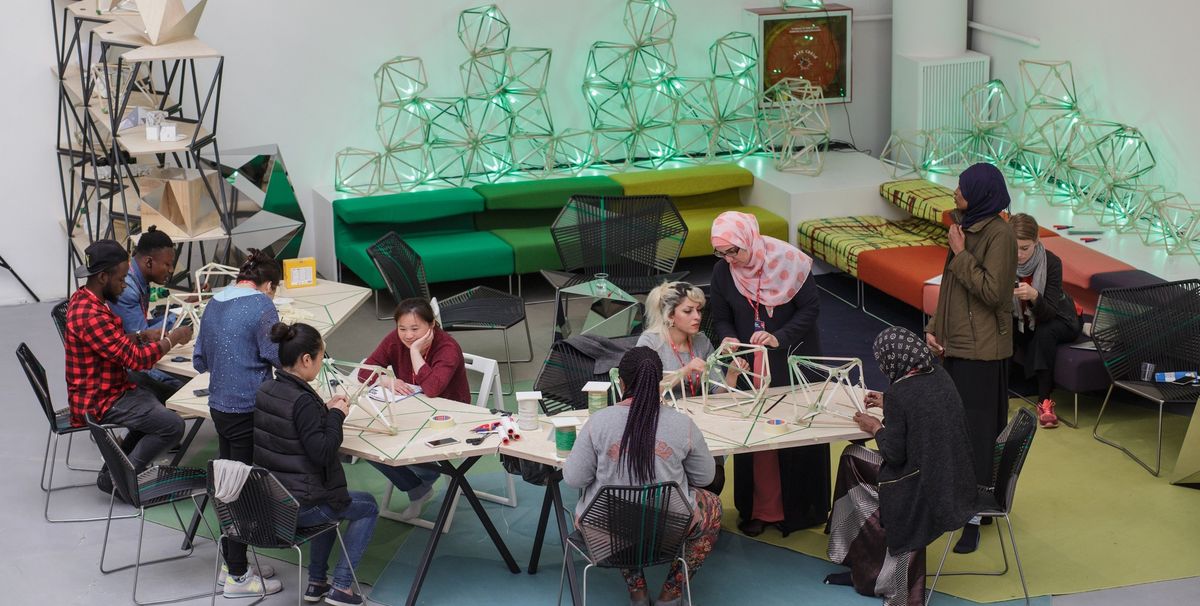No great Expo or World’s Fair was complete without a native village or two in the late 19th and early 20th centuries. The Midway at Chicago’s World’s Columbian Exposition in 1893 had a Dahomey village, with Africans in traditional dress, as did Paris’s Exposition Universelle in 1900. Caucasians were displayed as well as more “exotic” people. Young women, or “colleens”, in the Irish villages especially.
This year at the heart of the main exhibition at the Venice Biennale, the art world’s greatest gathering, there is a workshop where refugees and migrants, some from Africa, others from the Middle East, are making lamps designed by the Danish-Icelandic artist Olafur Eliasson. Visitors can join around 40 volunteer migrants, who are being housed on the Venetian mainland, to help them in their task until July and again in the autumn. The artist’s geometric design with an LED light is best put together by two people, so encouraging conversation.
Called Green light, the project was launched by Studio Olafur Eliasson and partners in Vienna last year. Venice is the art workshop’s most high-profile venue so far.
For some the context is very wrong. “I felt sickened by this human zoo,” wrote Jackie Wullschläger, the art critic of the Financial Times. Cristina Ruiz, a former editor of The Art Newspaper and another Venice Biennale veteran, was also unimpressed: “Let people interested in the project seek it out. Let the others gawp at something else. This is not art in service of migrants but migrants in service of a curatorial vision.”
The context is challenging. Another of Christine Macel’s curatorial choices does not help.
I agree with Ruiz and others about the Brazilian artist Ernesto Neto’s Sacred Place in the Arsenale. His giant tepee made of jute, where members of the Amazonian Huni Kuin can be found, has something of the Midway about it. An exotic show-stopper, in the accompanying didactic display the artist’s voice speaks loudest. But Green light feels different. It would have been diminished if it was a sideshow at the Biennale: art and activism as an add-on. It feels like a project designed and evolving to meet migrants’ real needs and encourage conversations. You need only speak to the migrants themselves to hear their thoughts and life stories (and critics of the project have so far failed to include the participant’s voices in their critiques).
One participant, Tahajud Alghrabi, a teacher from Baghdad who joined the project in Vienna, is now helping other refugees in Venice. During the preview week one young man from Nigeria, Jerry Angel, said frankly that if he wasn’t taking part in Green light he would probably be hanging out at a railway station drinking or possibly selling drugs.
The artist Mark Bradford’s contribution to Venice, beyond his US pavilion, is also based on him listening to what people in dire straits have told him they really need. He has backed, including financially, a shop where prisoners can sell the products they make in partnership with a local co-operative, Rio Terà dei Pensieri. It will stay open after the Biennale closes in November—Process Collettivo is a six-year project.
Eliasson and his partners in the Green light project are also in it for the long-term. This is not a feel-good photo-opportunity, and a far cry from “going slumming” and meeting have-nots in a Scandi design setting. Refugees and migrants have access to practical training, legal advice and language courses for free.
Before the project even had a name, Eliasson told us he was trying to find a way of using art for people who are not allowed to get the one thing they need most: a job. He revealed that one of the project partners in Venice, the Italian design firm Moroso, is creating jobs in Africa making a line of furniture. The project’s staging in Venice highlights just how difficult it is for migrants to find gainful employment in Europe.
A key part of Green light elsewhere is missing at the Biennale, however. Eliasson had designed an area where participants could eat together, as happened at workshops in Vienna and Houston. But permission for this was declined by the exhibition organisers, so communal lunches instead take place beyond the Biennale boundary in the Serra dei Giardini.
It would be ironic if Italy’s labour unions had nixed the proposal to let migrants serve food or if this has been barred because of rules about the catering concession in the exhibition (the Biennale declined to comment). At least coffee and water were allowed in the workshop space after preview week.


